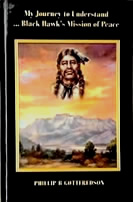
Moonch was the son of Turunianchi the Great and known to the Mormons as Old Uintah, Old Elk, and Big Elk.
During the battle at Fort Utah in 1850, one more loathsome act remained to unfold which would haunt the
Mormons for many decades to follow, even to the present day. Bill Hickman, one of Brigham Young's body guards, hacked Old Elk's head off from his frozen body, and
hung the head from the eves of his cabin. A witness at Fort Utah told reporters, "...it was hung pendant by its long hair
from the willows of the roof of one of the houses. I well remember
how horrible was the sight." - Robert Carter, author of the book Founding Fort Utah.
SETTLING OF UTAH VALLEY. COPIED FROM WHITNEY'S HISTORY OF UTAH. TROUBLE AT FORT UTAH (PROVO).
"It was with reluctance that the Timpanogos Indians who met the Higbee colony in March, 1848, permitted the first white settlement on Provo River, and that, too, in spite of the invitation previously extended to the colonists by the chiefs, Sowiette and Walker, to settle among their tribes and teach them how to become civilized. It has also been stated that soon after Fort Utah was founded, according to Colonel Bridger and Mr. Vasquez Timpanogos Chief Wakara (Walker) began stirring up the Indians against the "Mormon" settlers. In this movement Wakara was aided by another chief (Wakara's father) named Elk, variously styled Big Elk, Old Elk, etc., like himself a hater of the whites, and apparently quite as fond of fighting.
"It was with Big Elk and his band that the Provo settlers, in their first regular battle with the savages, had immediately to deal. It was believed by Governor Young that Colonel Bridger and other mountaineers were at the bottom of much of the ill-feeling manifested by the red men, and they were incited to attack the "Mormon" settlements. The Governor, (Brigham Young), however, seemed to have confidence in Mr. Vasquez, who had opened a small store in Salt Lake City, and whose interests to that extent were identified with those of the settlers." - Source: Peter Gottfredson Indian Depredations in Utah.
Two days after the battle at Fort Utah, General H. Wells arrived from Salt Lake and ordered young Black Hawk to lead serial killer Bill Hickman and his men up Rock Canyon to pursue the survivors. In freezing temperatures and deep snow, Black Hawk, having no choice in the matter, did as Hickman ordered and led the men up Rock Canyon. Lookouts scaled the canyon's steep walls as Wells and his men slowly made their way up the rugged canyon. Black Hawk reluctantly followed behind.
When they had reached the survivors' camp, women and children in terror were scattering. Hickman ordered Black Hawk to look in the teepees. There, Black Hawk saw his beloved great-uncle Old Elk frozen to death, and many others who had died of their wounds lay frozen stiff in the cold.
The Mormon vigilantes greedily helped themselves by taking from the dead their belongings. At the same time, Bill Hickman hacked Old Elk's head off from his frozen body with a knife in hand. He said Jim Bridger had offered him a hundred dollars for the head. Old Elk's wife refused to be taken captive, broke free, and ran for her life. She scaled the cliffs but either jumped or slipped and fell to her death. Hickman and his men returned to Fort Utah, where Hickman showed off his trophy, the head of Old Elk. Hence, the Mormons dubbed the canyon "Squaw Peak," located above the Provo LDS Temple. This name endures to this day.
Of the seventy or so warriors, only about thirteen had escaped. One of the warriors who managed to survive was taken captive. An-kar-tewets, the same one that Dimmick and the Higbee brothers had sworn an oath that no harm would come to the Natives and they would not take their land rights but given many gifts.
Dr. James Blake, a surgeon in the Stansbury company, was greatly influenced by Hickman's trophy of Old Elk's head. Dr. Blake ordered troops Abner Blackburn and James Orr to go out and behead each of the frozen corpses lying about in the snow following the two-day battle that resulted in the deaths of 70 Indian people. Dr. Blake told the men he "wanted to have the heads shipped to Washington to a medical institution." Note: There was a market for human remains; a head could fetch as much as $100 each.
The men hacked from the frozen corpses as many as 50 heads. They piled them in open boxes, along with a dozen or so Mallard ducks Blake had shot while his men performed their chore. Blake's troops took the heads and ducks to the fort and placed them in direct sight of Black Hawk, who was barely in his twenties, and his traumatized kin, who were innocent of any wrongdoing. They were forced to view the grizzly remains placed before them for two long and excruciating weeks. Following the agreement, Abner delivered the rotting heads and ducks to Blake in Salt Lake. Dr. Blake settled up and invited Abner to dinner. Abner Blackburn declined, saying he had lost his appetite.
Next: Battle Creek Canyon & Fort Utah
